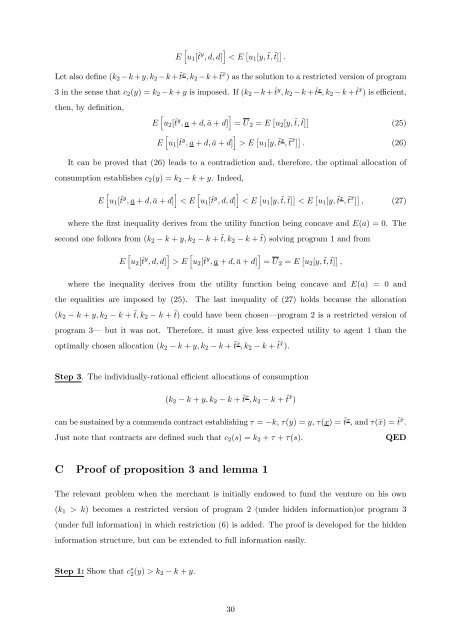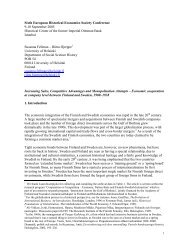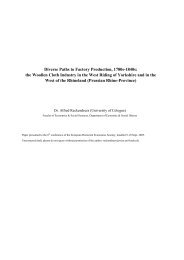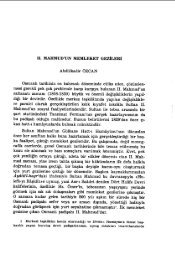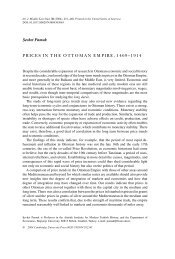The Birth of Insurance Contracts - The Ataturk Institute for Modern ...
The Birth of Insurance Contracts - The Ataturk Institute for Modern ...
The Birth of Insurance Contracts - The Ataturk Institute for Modern ...
Create successful ePaper yourself
Turn your PDF publications into a flip-book with our unique Google optimized e-Paper software.
E u1[ˆt y <br />
, d, d] < E u1[y, ˜t, ˜t] .<br />
Let also define (k2 −k +y, k2 −k + ˜t x , k2 −k + ˜t ¯x ) as the solution to a restricted version <strong>of</strong> program<br />
3 in the sense that c2(y) = k2 − k + y is imposed. If (k2 − k + ˆt y , k2 − k + ˆt x , k2 − k + ˆt ¯x ) is efficient,<br />
then, by definition,<br />
<br />
E u2[ˆt y <br />
, a + d, ā + d] = U 2 = E u2[y, ˜t, ˜t] <br />
(25)<br />
<br />
E u1[ˆt y <br />
, a + d, ā + d] > E u1[y, ˜t x , ˜t ¯x ] . (26)<br />
It can be proved that (26) leads to a contradiction and, there<strong>for</strong>e, the optimal allocation <strong>of</strong><br />
consumption establishes c2(y) = k2 − k + y. Indeed,<br />
<br />
E u1[ˆt y <br />
, a + d, ā + d] < E u1[ˆt y <br />
, d, d] < E u1[y, ˜t, ˜t] < E u1[y, ˜t x , ˜t ¯x ] , (27)<br />
where the first inequality derives from the utility function being concave and E(a) = 0. <strong>The</strong><br />
second one follows from (k2 − k + y, k2 − k + ˜t, k2 − k + ˜t) solving program 1 and from<br />
<br />
E u2[ˆt y <br />
, d, d] > E u2[ˆt y <br />
, a + d, ā + d] = U 2 = E u2[y, ˜t, ˜t] ,<br />
where the inequality derives from the utility function being concave and E(a) = 0 and<br />
the equalities are imposed by (25). <strong>The</strong> last inequality <strong>of</strong> (27) holds because the allocation<br />
(k2 − k + y, k2 − k + ˜t, k2 − k + ˜t) could have been chosen—program 2 is a restricted version <strong>of</strong><br />
program 3— but it was not. <strong>The</strong>re<strong>for</strong>e, it must give less expected utility to agent 1 than the<br />
optimally chosen allocation (k2 − k + y, k2 − k + ˜t x , k2 − k + ˜t ¯x ).<br />
Step 3. <strong>The</strong> individually-rational efficient allocations <strong>of</strong> consumption<br />
(k2 − k + y, k2 − k + ˜t x , k2 − k + ˜t ¯x )<br />
can be sustained by a commenda contract establishing τ = −k, τ(y) = y, τ(x) = ˜t x , and τ(¯x) = ˜t ¯x .<br />
Just note that contracts are defined such that c2(s) = k2 + τ + τ(s). QED<br />
C Pro<strong>of</strong> <strong>of</strong> proposition 3 and lemma 1<br />
<strong>The</strong> relevant problem when the merchant is initially endowed to fund the venture on his own<br />
(k1 > k) becomes a restricted version <strong>of</strong> program 2 (under hidden in<strong>for</strong>mation)or program 3<br />
(under full in<strong>for</strong>mation) in which restriction (6) is added. <strong>The</strong> pro<strong>of</strong> is developed <strong>for</strong> the hidden<br />
in<strong>for</strong>mation structure, but can be extended to full in<strong>for</strong>mation easily.<br />
Step 1: Show that c ∗ 2 (y) > k2 − k + y.<br />
30


